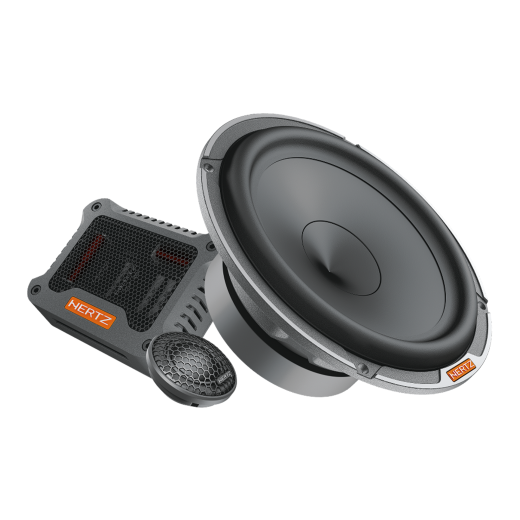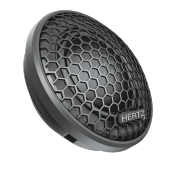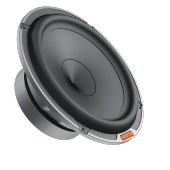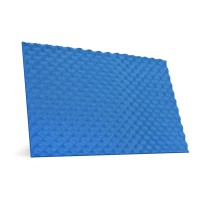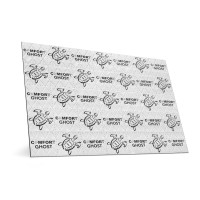Speakers Hertz MPK 1650.3 PRO
component speakers, Ø 165 mm, 125 W RMS, 3 Ω, 93 dB (2.83V/1m)
More about the product
More about the product
We will help you with your purchase
- Use our consulting room
- You can return the goods to us within 14 days
- Try the product at our store
Hertz MPK 1650.3 PRO component 2-way speakers
The MPK 1650.3 loudspeaker system is the pinnacle of the two-way system of the Mille PRO series. The system uses an MP 280.3 tweeter with a diameter of 28 mm. The geometry of the Tetolon dome maximizes typical off-axis listening dispersion. The rear acoustic chamber with damping material contributes to extending the response to lower frequencies and reaches a resonance frequency of only 900 Hz. In this way, the crossover point between the tweeter and the mid-bass can be reduced, improving the overall sound performance and the scene itself. A massive neodymium magnet minimizes the non-linearity of the music program control with very dynamic transitions. The CCAW (Copper Clad Aluminum Wire) coil guarantees extremely low weight and a rigid moving assembly. These technological elements work together. Included in the package is an elegant and compact angled tweeter accessory that allows for easy installation on both the A-pillars and the dashboard of the car. The correct angle of the tweeter improves the stereo sound stage, essential for an engaging listening experience.The electro-acoustic parameters of the MP 165P.3 mid-bass speaker have been created to provide a clear and solid sound of authentic mid-bass, designed for highly dynamic systems. The voice coil with a generous 14 mm height has a nominal impedance of 3 Ω in addition to increased power travel. These features make it possible to make maximum use of the performance of Hertz HCP and HDP amplifiers and other 2 Ω stable electronics. The 95mm diameter ferrite magnet allows for +/- 4.5mm of linear voice coil deflection, ensuring maximum control at all times. "Boundary Free Surround" moves more air and the V-cone® diaphragm profile improves dispersion, a true in-vehicle listening experience. In addition, the sophisticated basket made of aluminum alloy neutralizes unwanted vibrations.
The MPCX 165.3 crossovers create an optimal tonal balance between the MP 28.3 tweeter and the MP 165P.3 mid-bass. The two-position Hi-Contour control provides the ability to fine-tune the system's frequency response optimized for different speaker positions in the car. Above all, listeners can achieve their favorite sound thanks to the three-position tweeter sensitivity level control with 2 dB steps (+ 2/0 / -2 dB).
Main features of Hertz MP 28.3 tweeters
- Dual neodymium magnet optimized using FEA simulations.
- Tetolon dome optimized using FEA simulations for excellent dynamics and angle dispersion.
- Larger rear chamber to reduce Fs to 900 Hz.
- Non-woven material from natural fibers, for better damping and more natural acoustic emissions.
The main features of the mid-bass speakers Hertz MP 165P.3
- Impedance 3 Ω to use all the power of the amplifier.
- 14mm coil of copper wire wound on a polyamide molding, for exceptional power control.
- 95mm diameter magnet to maximize control.
- The Exponential V-cone® membrane profile of pressed pulp with cotton fibers combines stiffness and light weight for a wide frequency response. Diaphragm profile geometrically optimized for maximum linearity and dispersion.
- "Boundary Free" rubber suspension for better efficiency and a wider range of mid-bass frequencies.
- Low mounting depth, acoustically transparent aluminum alloy basket with elegant Hertz logo.
- A metal grille with the Hertz logo is included in the package.
The main features of Hertz MPCX 165.3 crossovers
- Two-position "Hi-Contour" control according to the position / angle of the tweeter to the listener.
- Three terminals for setting the tweeter level in 2 dB steps, for fine tuning.
- High-quality bimetallized 160 V polyester film capacitors with ultra-low DF, for maximum sound legibility.
| Catalog number | MPK 1650.3 |
| Brand | Hertz |
| Links | Official web presentation |
| Speaker typeCoaxial speakers: Coaxial speakers are characterized by a so-called all-in-one design. The tweeter and mid-bass speaker are in one basket. The advantage is simpler assembly, but thanks to the connection or proximity of the bands in one speaker, the sound quality will usually be reduced. As a rule, in the middle of the mid-bass speaker, there is a tweeter whose voice coil works in the second air gap of the common magnetic circuit. The three-way coaxial speaker consists of a mid-bass speaker, a center speaker and a separate tweeter in the front on a special beam. Component Speakers: Component speakers are characterized by a division into individual frequency bands, treble + mid-bass + or. bass band. The individual speakers can be placed completely separately, which results in a better sound and acoustic performance. In the vast majority of cases of component speakers, an external crossover is also supplied, which divides the treble, middle / mid-bass, and into the three-band the bass band or allows setting the decibel level of the tweeter (e.g. +2 dB, 0 dB, -2 dB), steepness (e.g. 6dB/Oct. 12dB/Oct.) or active or bi-amp connection. | Component 2 band |
| RMS powerRMS speaker power is the constant power of the entire system, not just one speaker or one side. This is also the performance of continuous use of the speakers. If the RMS power is exceeded for a long time, the speakers may be irreversibly damaged! | 125 W |
| Max. (maximum performancePeak performance , which the speaker can play for a moment (approx. 0.5 s), for example when hitting drums in a song. If the max power is exceeded, the speakers will usually be damaged! | 250 W |
| Sensitivity (SPL 2.83V/1m)Sensitivity, sensitivity or efficiency of the speaker. Speaker sensitivity is given in decibels (dB) and simply put, the higher the value, the lower the demands on the amplifier's power. This is a defacto rating of how a speaker converts watts to sound. Sensitivity ratings are in noise level measured at 1 meter from the speaker using 1 W (watt of power) or using 2.83 volts at the source at 1 meter. A higher decibel level means the speaker is louder with less power. For every 3 dB increase in sensitivity, the speaker requires half the power to reproduce the same volume. For example, if an 88 dB speaker needs 100 Watts to produce a certain volume, then a speaker with a sensitivity of 91 dB needs only 50 Watts to reach the same volume. | 93 dB |
| ImpedanceImpedance - measurement of electrical resistance. When buying speakers, it is important to make sure that the impedance matches the amplifier or car stereo you are using. Example: A 2 Ohm speaker cannot be connected to an amplifier that is only stable up to 4 Ohms! A 4 Ohm speaker can easily be used with an amplifier that is stable up to 2 Ohms. The most common speaker impedance today is 3 - 4 Ohm. | 3 Ω |
| Frequency rangeThe ability of the speakers to play a signal from the lowest frequency to the highest, or the speaker's ability to faithfully reproduce sound in a specific frequency band. Professionally: In the frequency range from 40 to 16,000 Hz, the vast majority of fundamental and overtones (harmonics) of all musical instruments are found. We are interested in the course of the radiated sound pressure in this range of frequencies when the loudspeaker system is supplied with constant power. We call this course the frequency characteristic, which tells us the level of radiated sound pressure in decibels (dB) depending on the frequency. The frequency characteristic of a speaker or speaker system can be expressed most succinctly with a graph. Mostly, however, the frequency characteristic is indicated by indicating the maximum tolerance of the sound pressure in the given frequency range, e.g. 50 to 15,000 Hz -+ 6 dB. Since the frequency characteristics of loudspeakers and systems in general are quite uneven, some manufacturers do not even specify this maximum tolerance of sound pressure in decibels in their catalogs for reasons of prestige. Data impoverished in this way is unfortunately worthless. What is valid is that the manufacturer offers a speaker system with a frequency range of 30 to 20,000 Hz, if he is worried about stating the maximum unevenness of the sound pressure in this range, because he can have a tolerance of, for example, +- 20 dB. The unevenness or undulation of the frequency curve in good speaker systems for high-quality music performance should not exceed +-3 dB in the 80 to 12,000 Hz band and +-6 dB in the 40 to 16,000 Hz band. Greater unevenness already depletes or emphasizes certain tonal areas, which can cause audible or even disturbing distortion. The proportion between fundamental tones and higher harmonics also changes, thereby changing the color of the sound, and individual musical instruments as well as the entire musical image sound unnatural. | 40 - 25000 Hz |
| The diameter of the mid-bass speakerWe state the diameter of the speaker as the diameter of the entire speaker, not including the mounts, when smaller speakers (87, 100, 130 mm) have extra mounts. Some speakers are oval and there the dimension is given in inches, always the shortest side to the longest side. One inch is approx. 2.5 cm. | 165 mm |
| Installation depth of the mid-bass speakerThe installation depth of the speaker is measured from the bottom edge of the magnet to the bottom edge of the tin, plastic or cast speaker basket, or speaker bearing surfaces. | 64 mm |
| Mid-woofer diaphragm materialThe material that was used for the speaker diaphragm. Don't be afraid of the paper, it surprisingly has a very natural and high-quality sound and, thanks to the surface treatment, it can withstand moisture without any problems. | Ball press with cotton fibers |
| Overall tweeter diameterThe total diameter of the tweeter is given as the diameter of the individual tweeter without the installation houses. | 35 mm |
| Tweeter dome materialThe shell material that was used in the manufacture of the tweeter. | Tetolone |
| Frequency crossover included in the packageThe crossover is an important part of defacto all loudspeakers. A crossover usually contains different resistor values, coil sizes, and capacitor types that fundamentally modify the sound. We describe below what the turnouts are for. Component Speakers: A crossover is part of every quality component speaker system. Its task is to ensure the distribution of frequencies that the amplifier produces in the entire acoustic spectrum of frequencies so that each of the speakers receives only that part of the band that it can optimally play in terms of efficiency and minimal distortion. Coaxial speakers: In most cases, coaxial loudspeakers have a simple crossover (6dB/Oct.) formed by a capacitor at the tweeter. | Yes (full-featured) |
| Options for setting the frequency crossoverThe unwritten rule is that the more expensive the speakers, the more options the crossover has for adjusting the sound. The most common way to adjust the crossover is attenuation on the tweeter. More advanced crossovers also offer the option of setting the steepness on the mid-bass and tweeter or adjusting the frequency range. | Yes |
| Cover grids included in the packageOriginal cover grilles in speaker packaging. | Yes |
| Price forIf the price is for a pair, the package always includes 2 pieces of everything, e.g. 2x mid-bass, 2x tweeter and 2x crossover. | Few |
Product comments
Evaluation
Product assembly
ask us
